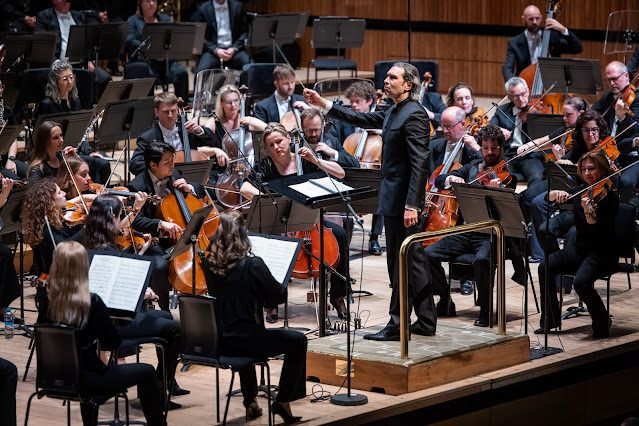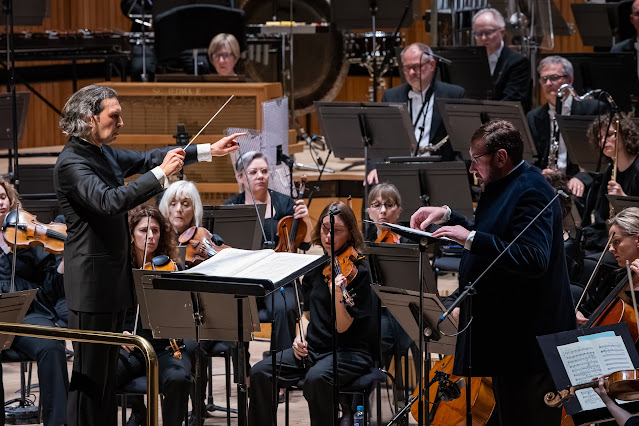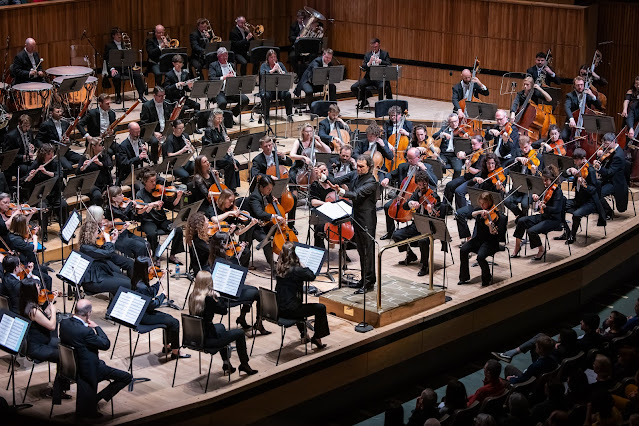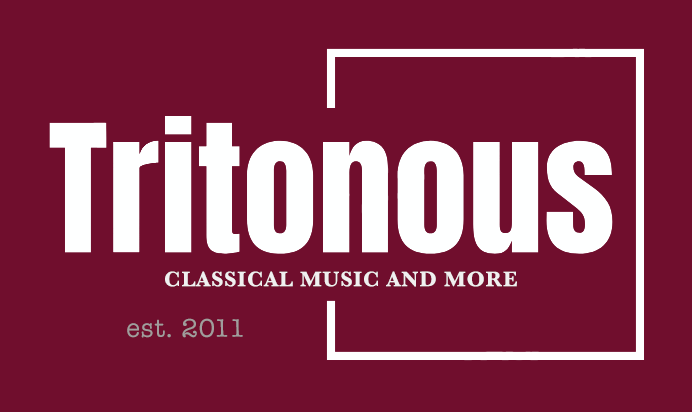 |
| Prokofiev: Suite from Semyon Kotko – Vladimir Jurowski, London Philharmonic Orchestra – Royal Festival Hall (Photo: Marc Gascoigne) |
Prokofiev, Mussorgsky/Denisov, Lyatoshynsky; Matthew Rose, London Philharmonic Orchestra, Vladimir Jurowski; London Festival Hall
Reviewed 2 April 2025
Ukrainian composer Boris Lyatoshynsky’s magnum opus, his war-inspired symphony at the centre of a powerful programme that also included Prokofiev’s marvellous music from his neglected opera Semyon Kotko
As part of the London Philharmonic Orchestra‘s Moments Remembered series at the Royal Festival Hall, conductor emeritus Vladimir Jurowski conducted a programme centred on Ukrainian composer Boris Lyatoshynsky’s Symphony No. 3, a work written in 1951 and coming directly out of the composer’s experience of the Second World War. To begin the programme, the Ukrainian theme continued with Prokofiev’s suite from his final opera, Semyon Kotko which depicts wartime struggle in a Ukrainian village. Not uncontroversially, between these two, Jurowski placed Mussorgsky’s song cycle Songs and Dances of Death in the orchestration by Edison Denisov with bass Matthew Rose.
 |
| Mussorgsky/Denisov: Songs & Dances of Death – Vladimir Jurowski, Matthew Rose, London Philharmonic Orchestra – Royal Festival Hall (Photo: Marc Gascoigne) |
Semyon Kotko was the first of Prokofiev’s two operas written on a Soviet subject and adhering to the tenets of Soviet realism. It was intended to have a first production directed by Prokofiev’s friend, Vsevolod Meyerhold, who was at that time the director of the Stanislavsky Opera Theatre. But the whole project seemed in danger when Meyerhold was arrested on 20 June 1939 and disappeared (he was shot in 1940). The production did happen and was respectably received, but the opera was set in a Ukrainian village in 1918 with fighting between the Red Army and the Germans. Semyon Kotko got mired in the Soviet Union’s complex relationship with Nazi Germany in 1939 and 1940, and after 1941 the opera was not produced. It only reappeared in 1958 in Brno, entering Russian opera theatres in the 1970s. It is still a rarity, and any UK performances have relied on visiting Russian opera companies.
As if sensing these problems, in 1943 Prokofiev created a suite from the opera. In eight movements, we heard six of them including missing out the triumphal final movement. Vladimir Jurowski’s father Michail Jurowski was a great champion of the suite. This is the Prokofiev of the famous ballets, with the ability to conjure lyricism and ravishing textures along with something more pointed. ‘
Introduction’ was lyric pastoral, yet full of colour with a sense of disturbance underneath the classicism. ‘Semyon and his mother’ continued the mood, introducing folk-like material, whilst ‘The Southern Night’ featured a marvellous long-breathed cello melody (quasi Romeo & Juliet) over a gorgeous orchestral texture. ‘Execution’ broke the mood with colourful and vivid violence, yet there were eerily disturbing elements too with the use of a strangely jaunty melody. ‘The Village is Burning’ began with lyricism threaded through with anxiety leading to moments of real violence. We ended with the penultimate movement, ‘Funeral’ with its tragic unfurling of a melody over a steady, inexorable beat, ultimately treading to nothing.
The music from the suite seemed marvellous and you wondered why we don’t hear it more often, and more to the point, whether the whole opera holds up.
Mussorgsky wrote Songs and Dances of Death for voice and piano, and though he had intentions to orchestrate the work, the piano version is much more than an orchestral sketch. [In their 2017 recording, Kathleen Broderick and Sergei Rybin demonstrated the work’s almost Debussy-esque qualities, see my review]. Rimsky Korsakov and Glazunov orchestrated the work after Mussorgsky’s death, thus contributing to the impression that the piano version is somehow unfinished. Shostakovich also made a version, as did the composer Edison Denisov (1929-1996) whose version was heard here. Denisov used a wide tonal palate with a large orchestra, yet used it delicately so that in each song the voice was showcased, surrounded by an aura of sound that never dominated. This was a version that brought out the remarkable nature of Mussorgsky’s original piano part.
The presentation of the work highlighted a number of issues. Why engage an English speaking singer for a work where the conversational nature of the Russian dialogue is so important. Couldn’t we have heard it in English, or would that be regarded as sacrilege? And given that it was in Russian, why did the printed programme feature only Cyrillic and the English translation, so the average audience member was unable to follow Matthew Rose’s detailed approach to the text, creating a sense of frustration with the performance.
Rose took a rather sober view of the piece, and offered little in the way of operatic drama that some singers bring to it. In many ways, the orchestral version is almost a series of short, highly dramatic quasi-operatic scenes. ‘Lullaby’ was spare and remarkably sober, whilst ‘Serenade’ was notable for the magical textures in Denisov’s orchestration which contrasted with Rose’s somewhat implacable Death figure. The vivid colour in ‘Trepak’ was in the orchestra, though the dance element took time to take off. Rose was strong in ‘The Field Marshall’ but not quite fearsome, only implacable towards the end when in fact he was overshadowed by the orchestra. But then it was clearly Jurowski’s performance. Rose was place at an angle on the platform so he had a clear view of Jurowski, and throughout the cycle it felt as if Rose was singing to Jurowski rather than us, that we were eavesdropping on the event rather than communicating directly.
Born in the Ukraine, then part of the Russian Empire, Boris Lyatoshynsky (1895-1968) studied with Reinhold Glière, and his mature music drew inspiration from modern European styles as well as Glière, and Ukrainian folk music. He would write five symphonies, two operas. Though his music was sanctioned by the Soviet authorities and his Symphony No. 2
was banned, Lyatoshynsky never adhered to Soviet realism in style,
though perhaps as a consequence many of his compositions were rarely
performed during his lifetime.
His Symphony No. 3 was written in 1951 and
though premiered in Kyiv, it was criticised by authorities because of
the finale with its subtitle of ‘Peace shall defeat war’. Rather than see the work banned, Lyatoshynsky gave in and refashioned the finale so that it pleased the authorities, but the original version has been receiving more currency and that is what we heard.
The work’s opening gesture was certainly uncompromising, full of menace with striking use of silence. This led to the opening ‘Allegro impetuoso’ with its fast, remarkably jagged first theme that felt not unlike Walton at times, and a contrasting folk melody that was sombre and rather chant-like. Anxiety and violence were a feature of the development section with moments of astonishing power. The movement concluded with a recapitulation of the earlier material, with a final, triumphant full-orchestral return of the folk melody. The slow movement began in gentle tranquillity, but became more intense with a big cello melody that seemed to come out of film music, when the folk melody from the first movement appeared it was accompanied by a steady tread that became implacable, yet we finished by returning to more intimate, tender music.
The third movement was fast, vivid and unstoppable, yet this changed to a strange, eerie transformation of the folk melody which became a waltz, but instead of a return to the opening material the music erupted into violence, before evaporating. The finale returned to the symphony’s opening gesture, yet not made more open and resolute and the movement had a strong sense of revisiting earlier material looking at it with new eyes, and ears. A mare martial element in the development blossomed into a full-blown triumphal statement leading to a climax with noisy bells.
 |
| Boris Lyatoshynsky: Symphony No. 3 – Vladimir Jurowski, London Philharmonic Orchestra – Royal Festival Hall (Photo: Marc Gascoigne) |
It is difficult, now, to see what the Soviet authorities found so objectionable in the work, but what is undoubtedly true is that it is a powerful and closely argued piece. Lyatoshynsky’s contemporary usage of symphonic form certainly owed something to contemporaries like Shostakovich, but his approach to symphonic form rather reminded me of Nielsen, whilst Lyatoshynsky’s own voice was clear. This was a terrific performance from all concerned, and such was the stature of the work that it made me want to hear more of Lyatoshynsky’s work in the concert hall.
The blog is free, but I’d be delighted if you were to show your appreciation by buying me a coffee.
Elsewhere on this blog
- Imagination & sense of drama: John Weldon’s 1701 prize-winning The Judgement of Paris in its first recording from Academy of Ancient Music & Cambridge Handel Opera Co – record review
- Up close and personal: David Butt Philip & Friends Gala at St Paul’s Opera, Clapham – opera review
- Pure enjoyment: Peter Moore & Tredegar Band give the first recording of Simon Dobson’s concerto for Moore – record review
- Bespoke Songs: soprano Fotina Naumenko on commissioning four composers for works for soprano and diverse ensembles – interview
- Richard Strauss at the Deutsche Oper Berlin:
- Elektra & Intermezzo – opera review
- Arabella with Jennifer Davis & Heidi Stober – opera review
- Traces of trauma: Britten Sinfonia premiere Michael Zev Gordon’s A Kind of Haunting marking 80th anniversary of the end of WWII – concert review
- Letter from Florida: Stéphane Denève & New World Symphony on impressive form in Britten’s War Requiem – concert review
- Drawing you in: young Uruguayan counter-tenor Agustin Pennino in a nadmirably ballsy programme at London Transport Museum – concert review
- Reshaping the narrative: Leslie Korngold on the historic release of his grandfather’s recording of his Symphony – interview
- Home





%20Ali%20Wright-28.jpg?w=670&resize=670,446&ssl=1)




